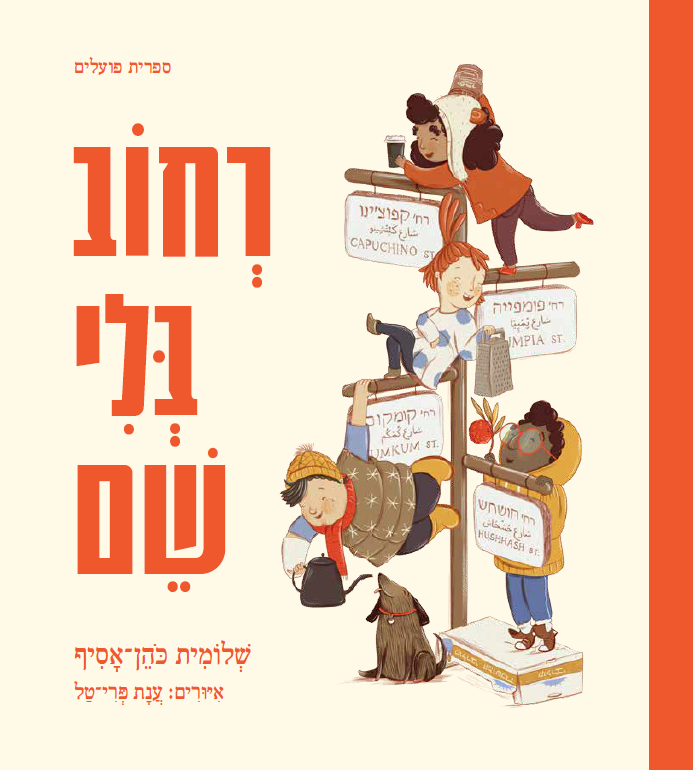
It is very confusing to live on a street with no name; Everyone is lost! In this new book, written by the beloved writer Shlomit Cohen-Asif, the children embark on a joint journey to choose a suitable name to their street.

It is very confusing to live on a street with no name; Everyone is lost! In this new book, written by the beloved writer Shlomit Cohen-Asif, the children embark on a joint journey to choose a suitable name to their street.
The children living on the street with no name do not accept their situation. They contact they mayor and make the following demand: "We want a name like every other street in town". This is a story about the importance of a name, and the power children have to make a difference, and right a wrong.
Read MoreDear Parents,
The children living on the street with no name do not accept their situation. They contact they mayor and make the following demand: "We want a name like every other street in town". This is a story about the importance of a name, and the power children have to make a difference, and right a wrong.
"In a place where there are no leaders, strive to be a leader" (Ethics of the Fathers, 2:5)
There are issues in life that bother all of us, but for which no one feels personally responsible. The Mishna in Ethics of the Fathers calls upon each of us to take action, initiate, and try to improve our surroundings. In A Street with no Name, many people are living on a street with no name, but it is the children who finally join forces in order to solve the problem. The story highlights the importance of being engaged, caring, and believing in our ability to change life for the better.
Enjoy reading and discussing the book together!
Безымянная улица
Автор: Шломи Коэн-Асиф
Иллюстратор: Анат При-Таль
Дорогие родители!
Дети живут на безымянной улице, но не желают мириться с таким положением вещей. Они обращаются к мэру города с требованием: «Пусть и у нашей улицы будет название, как у всех городских улиц». Эта книга о значимости имен и названий, а также о том, что детям под силу изменить действительность.
«И там, где нет людей, старайся быть человеком» (Трактат «Авот» 2, 5)
На протяжении жизни мы сталкиваемся с проблемами, которые мешают всем, но никто не желает брать на себя ответственность за их решение. Собрание Устного Закона Мишна призывает каждого из нас действовать, брать инициативу в свои руки, стараясь по возможности улучшить то место, где мы живем. Безымянная улица – это улица без названия, на которой проживает много людей, но только дети готовы взять на себя ответственность за решение проблемы. Это история о социальной ответственности, любви к окружающим и о вере в собственные силы.
Читаем и играем дома
• Рассмотрите внимательно иллюстрации. Удалось ли вам отыскать всех людей, заблудившихся на безымянной улице? А потерявшиеся вещи? Рассмешило ли вас что-либо в иллюстрациях?
• Есть ли название у улицы, на которой живете вы? Знают ли его ваши дети? В чью честь названа ваша улица? В Израиле улицам часто дают названия цветов, важных людей или исторических событий. Попытайтесь вместе отыскать смысл названия вашей и соседних улиц.
• Поищите на иллюстрациях уличные указатели. Как выглядят таблички в вашем районе? Часто названия улиц на указателях пишут на трех языках. Можете ли вы прочесть все названия? Попробуйте смастерить табличку для каждой из комнат квартиры, наподобие уличных указателей.
• Отправляйтесь на прогулку по вашему району. По дороге читайте указатели, интересуйтесь их смыслом. Обратите внимание, есть ли на улице фонари, скамейки, красивые деревья? Есть ли на вашей улице автобусная остановка? Где расположены пешеходные переходы? Вместе вы можете нарисовать карту района, в котором вы живете.
• Без названия улиц крайне сложно объяснить, как добраться из одного пункта в другой. Попытайтесь объяснить словами, как дойти от вашего дома к школе, не используя названий улиц, ориентируясь только по местным признакам. Затем вы можете начертить вместе карту и пройти пешком или проехать до места назначения, ориентируясь по ней. Не заблудились?
• Каждый из нас способен привести к положительным изменениям, будь то у себя дома или в своем районе. Поговорите об этом всей семьей, посоветуйтесь с соседями – возможно, что-то в вашем окружении требует изменений. Можно провести голосование и принять решение о цели и плане действий.
• Возможно, существует проблема, которую вам не решить своими силами, и вы хотели бы обратиться к мэру города? Найдите адрес обратной связи мэрии и отправьте электронное письмо с просьбой либо предложением. Может быть, и к вам приедет мэр собственной персоной.
• Подумайте о том, как дают имена улицам – о дискуссиях, о сложном выборе о приходе к консенсусу. Что вы думаете об этом процессе? Всегда ли, по вашему мнению, решения принимаются подобным образом? Когда это происходит иначе?
Приятного чтения и плодотворной беседы!